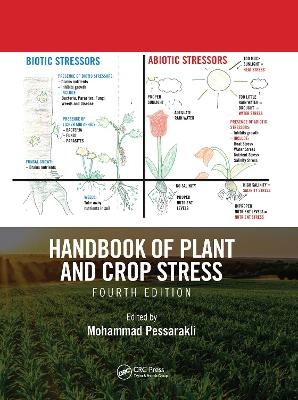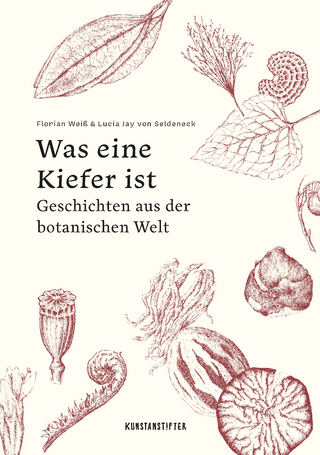
Handbook of Plant and Crop Stress, Fourth Edition
CRC Press (Verlag)
978-1-032-09031-3 (ISBN)
This volume presents 10 comprehensive sections that include information on soil salinity and sodicity problems; tolerance mechanisms and stressful conditions; plant/crop responses; plant/crop responses under pollution and heavy metal; plant/crop responses under biotic stress; genetic factors and plant/crop genomics under stress conditions; plant/crop breeding under stress conditions; empirical investigations; improving tolerance; and beneficial aspects of stressors.
Features:
Provides exhaustive coverage written by an international panel of experts in the field of agriculture, particularly in plant/crop stress areas
Contains 40 new chapters and 10 extensively revised and expanded chapters
Includes three new sections on plant breeding, stress exerted to weeds by plants, and beneficial aspects of stress on plants/crops
Numerous case studies
With contributions from 100 scientists and experts from 20 countries, this Handbook provides a comprehensive resource for research and for university courses, covering soil salinity/sodicity issues and plant/crop physiological responses under environmental stress conditions ranging from cellular aspects to whole plants. The content can be used to plan, implement, and evaluate strategies to mitigate plant/crop stress problems. This new edition includes numerous tables, figures, and illustrations to facilitate comprehension of the material as well as thousands of index words to further increase accessibility to the desired information.
Dr. Mohammad Pessarakli is a Professor in the School of Plant Sciences, College of Agriculture and Life Sciences at the University of Arizona, Tucson, AZ, USA. His work at the University of Arizona include research and extension services as well as teaching various courses in Plant Sciences and Stress Physiology. He is the Editor of the Handbook of Plant and Crop Stress and the Handbook of Plant and Crop Physiology (both titles published by, formerly Marcel Dekker, Inc., currently Taylor and Francis Group, CRC Press), Handbook of Photosynthesis, Handbook of Turfgrass Management and Physiology, and Handbook of Cucurbits. He has revised and expanded the first 3 volumes 3 times (1st, 2nd, & 3rd editions). The Editorial Board of the Advances in Plants & Agriculture Research (APAR) Journal unanimously voted and elected Professor Pessarakli as the Editor-in-Chief of the APAR in early 2016 for an unlimited term. Dr. Pessarakli has written over twenty book chapters, Editorial Board member of Journal of Plant Nutrition and Communications in Soil Science and Plant Analysis as well as Journal of Agricultural Technology, and a member of the Book Review Committee of Crop Science Society of America, and Reviewer of the Crop Science, Agronomy, Soil Science Society of America, and HortScience Journals. He is the author or co-author of over two hundred (200) journal articles and sixty (60) trade magazine articles. Dr. Pessarakli is an active member of the Agronomy Society of America, Crop Science Society of America, and Soil Science Society of America, among others. Professor Pessarakli is an Executive Board member of the American Association of the University Professors (AAUP), Arizona Chapter. Dr. Pessarakli is a well known Internationally recognized Scientist and Scholar and an esteemed member (invited) of Sterling Who’s Who, Marques Who’s Who, Strathmore Who’s Who, Madison Who’s Who, and Continental Who’s Who as well as numerous honor societies (i.e., Phi Kappa Phi, Gamma Sigma Delta, Pi Lambda Theta, Alpha Alpha Chapter). He is a Certified Professional Agronomist and Certified Professional Soil Scientist (CPAg/SS), designated by the American Registry of the Certified Professionals in Agronomy, Crop Science, and Soil Science. Professor Pessarakli is a United Nations Consultant in Agriculture for underdeveloped countries. He received the B.S. degree (1977) in Environmental Resources in Agriculture and the M.S. degree (1978) in Soil Management and Crop Production from Arizona State University, Tempe, and the Ph.D. degree (1981) in Soil and Water Science from the University of Arizona, Tucson. Dr. Pessarakli’s research interest is responses of plants/crops to environmental stresses (salinity, drought, and heat), and his environmental stress research work and expertise on plants and crops is internationally recognized.For more information about Dr. Pessarakli, the Editor, please visit http://cals.arizona.edu/spls/content/mohammadhttp://cals.arizona.edu/spls/people/faculty
Section I Soil Salinity and Sodicity Problems
Chapter 1 Soil Salinity and Sodicity as Particular Plant/Crop Stress Factors
[Mohammad Pessarakli and I. Szabolcs]
Section II Plants/Crops Tolerance Mechanisms and Stressful Conditions
Chapter 2 Roles and Mechanisms of Rhizobacteria in Regulating Plant Tolerance to Abiotic Stress
[William Errickson and Bingru Huang]
Chapter 3 Physiological, Biochemical and Molecular Mechanisms Regulating Post-Drought Stress
Recovery in Grass Species
[Cathryn Chapman and Bingru Huang]
Chapter 4 Regulatory Mechanisms for Stress-Induced Leaf Senescence
[Stephanie Rossi and Bingru Huang]
Chapter 5 Mechanisms of Salt Tolerance in Submerged Aquatic Macrophytes
[Rout Nutan Prasad, Shaw Birendra Prasad, and Rodriguez-Garay Benjamin]
Chapter 6 Oxidative Stress in Plants: Production, Metabolism, and Biological Roles of Reactive Oxygen Species
[Mojtaba Kordrostami, Babak Rabiei, and Ali Akbar Ebadi]
Chapter 7 Oxidative Stress and Antioxidative Defense System in Plants Growing under Abiotic Stresses
[Pallavi Sharma, Ambuj Bhushan Jha, and Rama Shanker Dubey]
Chapter 8 Plant Biochemical Mechanisms for the Maintenance of Oxidative Stress under Control Conditions
[Diego G. Arias, Claudia V. Piattoni, Sergio A. Guerrero, and Alberto A. Iglesias]
Chapter 9 Role of Proline and Other Osmoregulatory Compounds in Plant Responses to Abiotic Stresses
[Ehsan Shakeri, Ali Akbar Mozafari, Fatemeh Sohrabi, and Armin Saed-Moucheshi]
Chapter 10 Role of Dehydrins in Plant Stress Response
[Klara Kosova, Ilja Tom Prasil, and Pavel Vitamvas]
Chapter 11 Strigolactone Plant Hormone's Role in Plant Stress Responses
[Fatemeh Aflaki, Arman Pazuki, and Mohammad Pessarakli]
Chapter 12 Plant Abiotic Stress Proteomics: An Insight into Plant Stress Response at Proteome Level
[Klara Kosova, Milan Oldrich Urban, Pavel Vitamvas, and Ilja Tom Prasil]
Section III Plants and Crops Responses: Physiology, Cellular and
Molecular Biology, Microbiological Aspects, and Whole
Plant Responses under Salt, Drought, Heat, Cold
Temperature, Light, Nutrients, and Other Stressful Conditions
Chapter 13 Responses of Photosynthetic Apparatus to Salt Stress: Structure, Function, and Protection
[M. Stefanov, A.K. Biswal, M. Misra, A. N. Misra, and E.L. Apostolova]
Chapter 14 Responses of Plants to Stresses of the Sonoran Desert
[Thomas W Crawford, Jr]
Chapter 15 Stresses in Pasture Areas in South-Central Apennines, Italy, and Evolution at Landscape Level
[A. Fatica, L. Circelli, E. Di Iorio, C. Colombo, T. W. Crawford, Jr. and E. Salimei]
Chapter 16 Turfgrass Nutrient Management under Stresses: A Part of Integrated Stress Management
[Haibo Liu, Nick Menchyk, Frank Bethea, Christian Baldwin, Jacob Taylor, and Caleb Patrick]
Chapter 17 Nutrient Management of Golf Course Putting Greens under Stress
[Haibo Liu, Nick Menchyk, Frank Bethea, Christian Baldwin, Jacob Taylor, and Caleb Patrick]
Chapter 18 Molecular Chaperones and Acquisition of Thermotolerance in Plants
[Hitoshi Nakamoto and Tahmina Akter]
Chapter 19 Phytohormone Homeostasis and Crosstalk Effects in Response to Osmotic Stress
[Omid Askari-Khorasgani and Mohammad Pessarakli]
Chapter 20 Heliotropism: Plants Follow the Sun
[Yehouda Marcus]
Chapter 21 Carbon Metabolic Pathways and Relationships with Plant Stress
[Carlos M. Figueroa, Romina I. Minen, Florencio E. Podesta, and Alberto A. Iglesias]
Chapter 22 Protein Synthesis by Plants Under Stressful Conditions
[Pallavi Sharma and R. S. Dubey]
Chapter 23 Ultraviolet Effects on Plants: Harmful or Beneficial?
[Arman Pazuki, Fatemeh Aflaki, and Mohammad Pessarakli]
Section IV Plants and Crops Responses under
Pollution and Heavy Metal Stresses
Chapter 24 Plant Heavy Metal Interactions and Pollution Stress
[Mojtaba Kordrostami, Ali Akbar Ebadi, Babak Rabiei, and Mohammad Mafakheri]
Chapter 25 Plant Responses to Stress Induced by Toxic Metals and Their Nanoforms
[Kralova Katarina, Masarovicova Elena, and Jampilek Josef]
Chapter 26 Turfgrass Hyper-Accumulative Characteristics to Alleviate Heavy and Toxic Metal Stresses
[Haibo Liu, Nick Menchyk, Frank Bethea, Christian Baldwin, Jacob Taylor, and Caleb Patrick]
Section V Plant and Crop Responses under Biotic Stress
Chapter 27 How Crops Stress Weeds
[Jack Dekker]
Section VI Genetic Factors and Plant/Crop Genomics under Stress Conditions
Chapter 28 Candidate Gene Expression Involved in Plant Osmotic Tolerance
[Mojtaba Kordrostami and Ali Akbar Ebadi]
Chapter 29 Drought-Induced Gene Expression Reprogramming Associated with Plant Metabolic Alterations and
Adaptation
[Omid Askari-Khorasgani and Mohammad Pessarakli]
Section VII Plant/Crop Breeding under Stress Conditions
Chapter 30 Marker-Assisted Breeding for Disease Resistance in Legume Vegetable Crops
[Bhallan Singh Sekhon, Akhilesh Sharma, and Rakesh Kumar Chahota]
Chapter 31 Breeding for Improved Crop Resistance to Osmotic Stress
[Mojtaba Kordrostami and Babak Rabiei]
Chapter 32 Breeding for Improved Plant-Symbiont Thermotolerance and Symbiotic Performance by
Regulating Heat Shock Proteins, RNA Binding Proteins, and Chaperones
[Omid Askari-Khorasgani and Mohammad Pessarakli]
Section VIII Examples of Empirical Investigations of Specific
Plants and Crops Grown under Salt, Drought,
and Other Environmental Stress Conditions
Chapter 33 Abiotic Stress Impact and Tolerance of Natural Sweetener Plant Stevia
[Rout Nutan Prasad, Rodriguez-Garay Benjamin, Barranco-Guzman Angel Martin, Gomez-Entzin
Veronica, and Rincon-Hernandez Manuel]
Chapter 34 Responses of Green Beans (Phaseolus vulgaris L.) in Terms of Dry Matter Production,
Nitrogen Uptake, and Water Absorption under Salt Stress Conditions
[Mohammad Pessarakli]
Chapter 35 Growth Responses of Pepper Plant (Capsicum annuum L.) in Terms of Biomass Production and
Water Uptake under Deficit Irrigation System, Mild Water Stress Conditions
[Sara Mardani, Mohammad Pessarakli, and Rachel McDaniel]
Chapter 36 Effects of Salinity Stress on Tomato Plants and the Possibility of Its Mitigation
[Maryam Mozafarian Meimandi, Noemi Kappel, and Mohammad Pessarakli]
Chapter 37 Water Stress Effects on Growth and Physiology of Corn
[M. Anowarul Islam and Abdelaziz Nilahyane]
Chapter 38 Moisture Stress and Its Effects on Forage Production Systems
[M. Anowarul Islam and Albert T. Adjesiwor]
Chapter 39 Responses of Medicinal Plants to Abiotic Stresses
[Masarovicova Elena, Kralova Katarina, Vykoukova Ivana, and Zuzana Krissakova]
Chapter 40 Citrus Plant Botanic Characteristics and Its Abiotic and Biotic Stress
[Hong Li]
Section IX Future Promises: Improving Plant and Crop Adaptation/Tolerance and Cultivation under Stressful Conditions
Chapter 41 Improving Crop Resistance to Abiotic Stresses Through Seed Invigoration
[M. Farooq, A. Wahid, S.M.A. Basra, Abdul Rehman, and Kadambot H.M. Siddique]
Chapter 42 Drought Resistance of Tropical Forage Grasses: Opening a Fertile Ground for Innovative Research
[Juan Andres Cardoso and Idupulapati M. Rao]
Chapter 43 Drought Resistance of Common Bean Water Spending and Water: Saving Plant Ideotypes
[Jose A. Polania and Idupulapati M. Rao]
Chapter 44 Moringa and Tamarind: Potential Drought-Tolerant Perennial Crops
[Satya S.S. Narina, Christopher Catanzaro, and Anwar H. Gilani]
Chapter 45 Relationship of Medicinal Plants and Environmental Stresses: Advantages and Disadvantages
[Amir Hossein Saeidnejad]
Chapter 46 The Role of Beneficial Elements in Mitigation of Plant Osmotic Stress
[Maryam Mozafariyan Meimandi, Noemi Kappel, and Mohammad Pessarakli]
Chapter 47 The Role of Grafting Vegetable Crops for Reducing Biotic and Abiotic Stresses
[Maryam Mozafarian Meimandi and Noemi Kappel]
Chapter 48 Why Root Morphology is Expected to Be a Key Factor for Crop Salt Tolerance
[Uwe Schleiff]
Chapter 49 Improving Plant Yield and Quality under Normal and Stressful Conditions by Modifying the
Interactive Signaling and Metabolic Pathways and Metabolic Interaction Networks
[Omid Askari-Khorasgani and Mohammad Pessarakli]
Section X Beneficial Aspects of Stress on Plants/Crops
Chapter 50 Beneficial Effects of Various Environmental Stresses on Vegetables and Medicinal Plants for the
Production of High Value-Added Plants
[Satoru Tsukagoshi and Wataru Yamori]
| Erscheinungsdatum | 01.07.2021 |
|---|---|
| Reihe/Serie | Books in Soils, Plants, and the Environment |
| Zusatzinfo | 40 Illustrations, color; 124 Illustrations, black and white |
| Verlagsort | London |
| Sprache | englisch |
| Maße | 210 x 280 mm |
| Gewicht | 2245 g |
| Themenwelt | Naturwissenschaften ► Biologie ► Botanik |
| Technik ► Umwelttechnik / Biotechnologie | |
| Weitere Fachgebiete ► Land- / Forstwirtschaft / Fischerei | |
| ISBN-10 | 1-032-09031-6 / 1032090316 |
| ISBN-13 | 978-1-032-09031-3 / 9781032090313 |
| Zustand | Neuware |
| Informationen gemäß Produktsicherheitsverordnung (GPSR) | |
| Haben Sie eine Frage zum Produkt? |
aus dem Bereich


